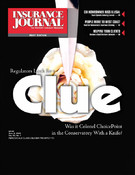Which comes first, the chicken or the egg? There is a general perception that agency value has been increasing the past few years. This belief is partially true and is the result of a self-fulfilling prophecy.
In the past few years there have been some notable acquisitions of agencies that seemed to push the agency value envelope. For some cases, banks were making their platform acquisition and thus willing to pay top dollar to their first acquisition of a large, well-run firm. In other cases, publicly traded firms were able to exploit their high price-to-earnings ratio to offer a high price to the seller.
In reality, many of these deals were not quite as sweet as the word on the street. Large cash down payments provided a great start for the seller, but the next level of the purchase price was often tied to future performance. If the future performance goals were not met, then payments beyond the down payment might not be realized.
One must keep in mind that many of the famous lucrative deals were done between 2000 and early 2004. It was during much of this time that the hard market for commercial lines was in full swing. Employee benefits increased at a double-digit pace for the past several years as well. Projected growth rates looked tremendous for insurance agencies. Sellers could play off these growth rates to project large future profits.
Buyers at that time, especially those outside of the insurance industry, had been willing to accepted projections of double-digit growth (even as high as 30 percent) for the next few years. By using such large growth over several years, a high value can be demonstrated by using the future earnings method of calculating value.
Also during this time period, Profit/Expense ratios for publicly traded brokers were peaking. The publicly traded firms were able to use their high P/E ratios to make lucrative offers to sellers.
Another factor is that changes to accounting rules provide more favorable write offs of purchases by publicly traded firms. Last year buyers were still in high gear. Brown & Brown, Arthur J. Gallagher and Willis each did 22, 17 and 10 acquisitions respectively during 2004.
The question is … “Have the fundamentals of agency value changed?”
Understanding agency value
Agency value is based on profitability and risk. For the most part, profitability has been flat. The hard market has added some nice growth on the top line without much added expenses. However, expenses increased independently of the hard market. Staff compensation, employee benefits, automation and errors and omissions insurance all increased during the past few years, having a neutralizing effect on revenue growth.
So, the first part of value–profitability–has not changed much, so this would not indicate an increase in value. Risk–the second part of agency value–has not changed when looking at the overall industry. So, when factoring in these two elements of value, it appears that value should not have changed much the past few years.
There is a third factor in agency value–the marketplace. Perception becomes reality. If buyers outnumber sellers, then the sellers will be able to play the buyers against one another, to pump up the price. Sellers also hear the legends of other sellers getting high prices, so sellers become more willing to hold out for the big bucks. Herein lies the self-fulfilling prophecy.
Because of the marketplace factor, agency value did increase between 1999 and 2004. As business appraisers, our firm has noticed an overall increase in value from about 10 percent to 25 percent during this period. Profitable, well-run firms posted increases from 20 percent to 35 percent.
So will the good times keep on rolling? The trend is for the rate of increase to drop. With the advent of the soft market, profitability will decrease so the return on investment will correspondingly decrease. Buyers however will still outnumber sellers so the marketplace factor will be a key. The “speculative seller” will not sell for the true intrinsic value of the firm but only for the perceived premium value of the firm, which will keep the marketplace value floating.
A Final Thought
There is no magic to increasing the firm’s value. There are many factors that a buyer considers when looking at buying an agency. The main consideration is the ability to create and sustain a profit. The two key factors an owner has comparative control over are profitability and risk. Capitalizing on the interest of the marketplace requires good timing from the seller.
Most buyers are interested in well-run firms that would enhance their current business situation. Agencies that are poorly managed have fewer interested buyers and often get low offers for the business.
A good credo to follow is to always run a business as if it is going to be sold today. Streamlined operations have fewer problems and generate better bottom line profits. The owners of these agencies will make more money now and in the future.
Bill Schoeffler, CIC, and Catherine Oak, CIC, CRM, are partners at the international consulting firm Oak & Associates. The firm specializes in financial and management consulting for independent insurance agents and brokers. They can be reached at (707) 935-
6565, by e-mail at bill@oakandassociates.com,
or visit www.oakandassociates.com.
Topics Agencies Personal Auto Market
Was this article valuable?
Here are more articles you may enjoy.


 Industry Critiques Trump’s Auto Insurance Rate Data, Promise to Cut Premiums
Industry Critiques Trump’s Auto Insurance Rate Data, Promise to Cut Premiums  Flooding in Central Europe Could Cause Billions in Economic Losses, Analysts Say
Flooding in Central Europe Could Cause Billions in Economic Losses, Analysts Say  US Sues Ship Owner, Operator Over Baltimore Bridge Collapse
US Sues Ship Owner, Operator Over Baltimore Bridge Collapse  Report: Over 250,000 US Properties Have Repeated NFIP Claims
Report: Over 250,000 US Properties Have Repeated NFIP Claims 


